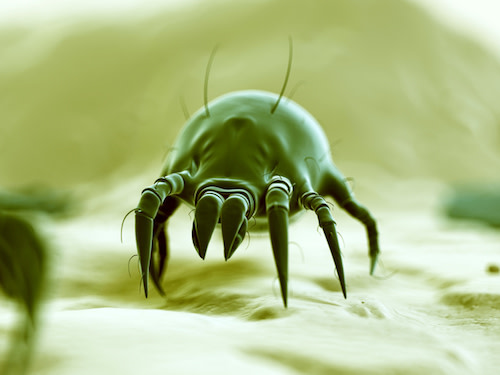Dust Mite Allergies: Causes, Symptoms, and Finding a Solution
But if you who suffer from dust and dust mite allergies you need to do more than just think about it. You need to make strategic changes to keep these virtually-invisible bugs from causing serious health problems.
While most people will never notice dust mites, they can be a serious concern for allergy suffers. With the right information, however, you can control the issue.

What are Dust Mites?
Dust and dust mites are two very different things. Dust mites are microscopic organisms that commonly live in and feed on house dust. They are so small that you can’t see them with the naked eye; the only way to view them is through a microscope.House dust mites are related to ticks and spiders. They eat skin cells shed by people, and their favorite living conditions are warm, humid environments. The most ideal living places for dust mites in a home is bedding, upholstered furniture, and carpeting.
Dust mites leave a debris that is so light and small that it becomes airborne. This debris is the cause of dust mite allergies.

Signs and Symptoms of Dust or Dust Mite Allergies
The symptoms of a dust mite allergen are very similar to the typical symptoms of seasonal hay fever and other respiratory allergies. The allergic reaction often starts with sneezing and a runny nose, although it can also include itchy, irritated eyes. Nasal congestion is common, and coughing often occurs. Victims of dust mite allergies may also experience facial pressure and swollen, bluish skin under the eyes.If you have asthma in addition to dust mite allergies, you can also have problems that include difficulty breathing and chest tightness. Because dust mite allergies cause problems with breathing, it makes asthma more difficult to manage and it could increase the frequency and severity of asthma attacks. It’s common for sufferers to have trouble sleeping because of shortness of breath, which can cause its own complications.

Diagnosing Dust Mite Allergies
But how can you know if you’re allergic to dust and dust mites, and not something else?If you find that your symptoms are worse when you go to bed or while you are cleaning, the problem may be caused by dust mites.
To diagnose the issue, your doctor may recommend a skin test. In this test, a specialist (often a doctor called an “allergist”) essentially places a small amount of specific allergens onto a scratch or prick in your skin. The doctor will then observe the allergic reaction after roughly 15 minutes have passed. Through multiple tests, the doctor can determine the cause of your allergies.
The allergist may also perform an allergy blood test, which uses a sample of blood for lab testing against various allergens. This test only requires one needle stick (compared to multiple scratches of a skin test), making it more desirable for testing children or people with skin conditions.
Risk Factors for Dust Mite Allergies
While anyone can potentially develop dust mite allergies, there are a few risk factors that could make you more susceptible to the problem. If you have a family history of allergies, you are more likely to develop allergies to dust mites.It’s also believed that if you have been exposed to high levels of dust and dust mites, especially as a young child, you will be more likely to have problems. People are more likely to develop allergies at a young age, so if you are older and do not have dust mite allergies, your chances of developing symptoms are less.
Controlling Your Dust and Dust Mite Allergens
The best strategy for controlling dust and dust mite allergens is to limit exposure as much as possible. This means keeping a clean home.You’ll want to start by cleaning in the bedroom, as this is a common hideout for dust mites and where we spend much of our time. Thoroughly clean your bedding, and consider using plastic air-tight covers over pillows, mattresses, and box springs. Pillows with polyester fibers, as opposed to feathers, are often better for controlling dust mites. Wash your bedding in hot water at least once a week, and dry the bedding in a hot dryer. The heat will help kill dust mites. If your bedroom is in the basement, consider moving into an upstairs room. Basements can be damp, which is the preferred environment for dust mites.
Clean and vacuum the home often to remove dust. If you are concerned about dust mites, consider purchasing a vacuum cleaner with a HEPA filter, which will remove a significant portion of allergens. People with particularly severe allergies may even want to consider replacing wall-to-wall carpeting with hard flooring, as carpet creates a hiding spot for allergens.
Medicines for a Dust Mite Allergy
Sometimes basic home cleaning and even adjustments to the house may not be enough. In these situations, you may need to turn to over-the-counter or prescription medication to control your dust mite allergy. We would encourage you to speak with your doctor or an allergist before making any decisions on medication.Over-the-counter drugs for allergies are commonly used to control symptoms and provide temporary relieve. Antihistamines, which slow the body’s immune response (the cause of allergies) are used to relieve many of the problems, including sneezing, watery eyes, and itching. Decongestants can be used to ease nasal clogging or relieve a stuffy nose.
It’s also possible to get allergy shots, which treat allergies over a longer period. Certain prescription medications can also be effective. Be sure to speak with your doctor to see which medications will be right for you.
Unfortunately, it is impossible to completely cure dust mite allergies, but with the right approach to healthy living and the right medications, you may be able to control your condition.
Home Appliances for Controlling Dust and Dust Mite Allergies
Dehumidifiers
Dust mites love a damp environment, so using a dehumidifier throughout the home can be beneficial to controlling their population. A dehumidifier used in the basement, in the living room, and especially in the bedroom will help you keep these bugs from finding a comfortable home. If you run a dehumidifier, be sure to keep the tray clean and empty it regularly.Air Purifiers
Virtually all types of air purifiers can help reduce the amount of allergens in the air, but some are more effective at reducing the amount of dust particles. By using an air purifier for dust, you reduce the amount of available food for dust mites and make it more difficult for them to thrive in your home.Advanced HEPA Air Purifiers for Reducing Airborne Allergens
The right air purifier can help reduce allergens in the home and the office. Contact our team and we’ll help you decide which air purifiers are right for your specific needs.With advanced technologies, including HEPA filters, activated carbon, and UV light, our air purifiers can create cleaner air for everyone!
